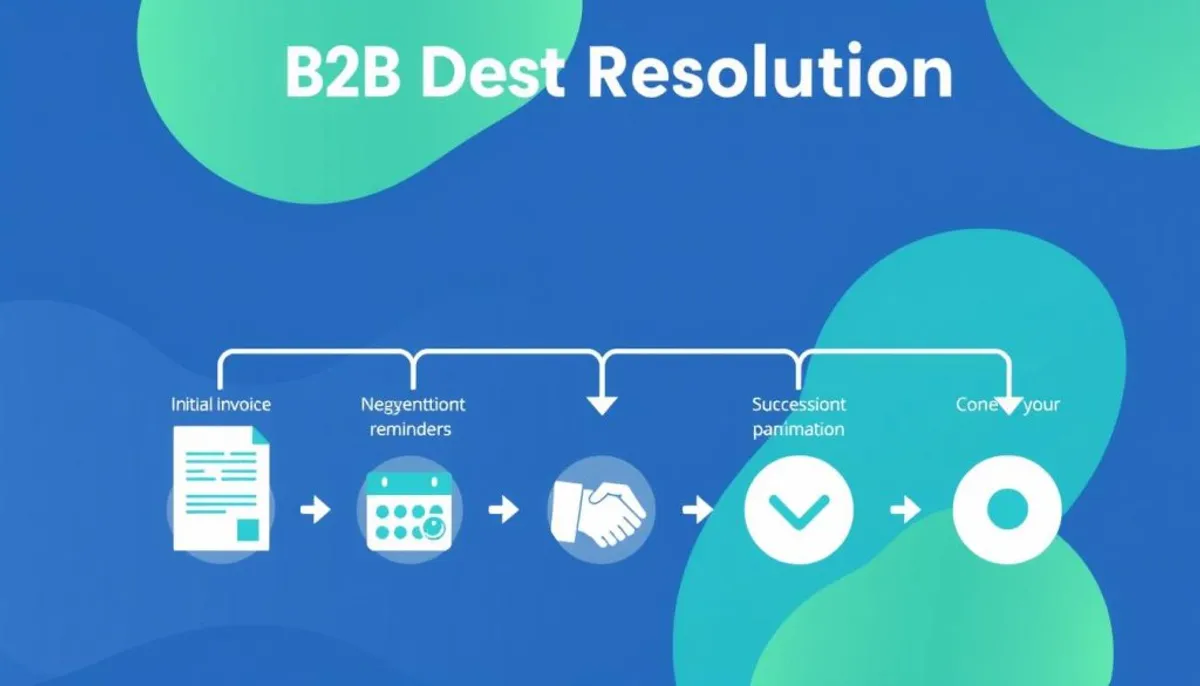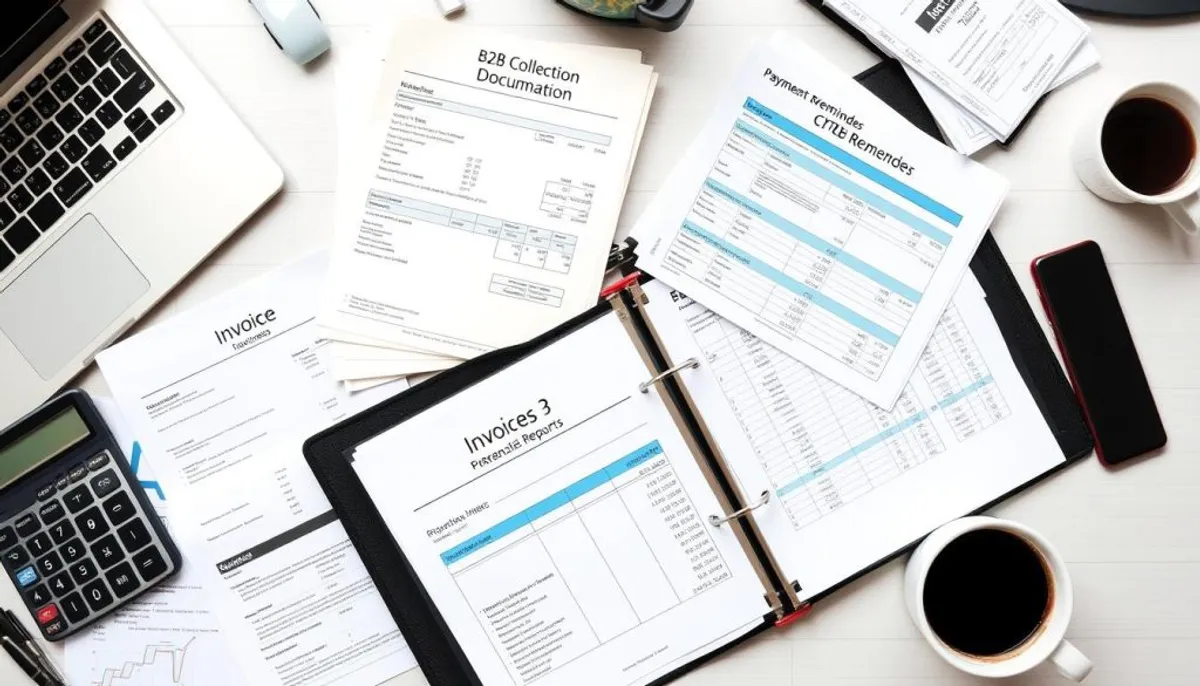In the realm of business-to-business (B2B) transactions, the implementation of effective collection strategies is paramount for sustaining financial health and promoting growth. The efficacy of B2B collection practices can decisively influence a company’s financial stability. We will explore essential strategies aimed at enhancing accounts receivable management and ultimately boosting your financial performance.
Clear communication stands as a cornerstone in B2B collections. Approximately 70% of businesses that explicitly outline payment instructions on their invoices witness expedited payment cycles. This straightforward action can substantially enhance your cash flow and diminish the necessity for subsequent follow-ups.

Adopting a systematic approach to follow-ups can significantly enhance on-time payment rates. For example, initiating an email reminder at 15 days past due, followed by a physical letter at 30 days, and culminating in a phone call at 45 days can effectively maintain payment schedules. This methodical approach ensures that no overdue account is overlooked.
Incentivizing early payments represents another potent strategy within B2B collections. Offering discounts for prompt settlements can motivate clients to expedite their payments, thus enhancing your cash flow. It is noteworthy that in B2B collections, the magnitude of accounts is typically greater than in consumer collections, underscoring the importance of timely payments.
Key Takeaways
- Clear payment instructions improve payment times
- Systematic follow-ups enhance collection effectiveness
- Early payment incentives boost cash flow
- Larger account sizes in B2B require special attention
- Transparency about penalties is crucial
- A/R automation can streamline collection processes
- Regular policy reviews lead to more efficient billing cycles
Understanding the B2B Collections Landscape
The realm of B2B collections diverges significantly from the recovery of consumer debt. It necessitates a profound comprehension of commercial debt collection methodologies and strategies for mitigating credit risks. Let’s dissect the pivotal elements of B2B debt resolution.
Key Differences from Consumer Collections
B2B collections entail larger financial sums and protracted payment durations. Unlike consumer debt, business transactions frequently incorporate complex payment terms. This necessitates a methodical approach to commercial debt collection.
Impact on Business Relationships
Efficient B2B debt resolution relies on fostering positive partnerships. Businesses must navigate the delicate balance between fiscal prudence and relationship maintenance. Employing personalized outreach and proactive measures is essential for mitigating late payment risks.
Modern Collection Challenges
Today’s B2B environment poses distinct challenges:
- Managing cash flow amidst extended payment cycles
- Navigating multiple stakeholders in each transaction
- Adapting to evolving payment technologies
- Balancing automation with personalized approaches
Overcoming these obstacles demands a combination of strategic acumen and cutting-edge tools. Businesses adept in B2B collections can enhance their financial performance and solidify their market standing.
Common B2B Collection Mistakes to Avoid
B2B debt recovery is fraught with challenges. Many businesses incur significant losses due to avoidable errors. It’s essential to recognize and avoid these pitfalls to enhance your delinquent account recovery efforts.
One critical mistake is the lack of clear credit policies. Without established guidelines, companies are 40% more likely to encounter payment disputes and delays. It’s vital to define clear terms for credit extension, including interest rates and payment schedules.
Another common error is neglecting early communication. Prompt follow-up within the first week of a missed payment can significantly boost recovery rates by 25%. Employing various communication channels, such as emails and phone calls, can greatly enhance debt collection success.
- Failing to document interactions
- Not leveraging technology
- Waiting too long to seek professional help
Businesses that document interactions have a 30% higher success rate in resolving debts amicably. The use of automated systems can reduce average days sales outstanding by 20%. Outsourcing to specialized agencies can also increase successful collections by 15-20%.
Effective B2B debt recovery hinges on proactive measures. Conduct thorough credit checks before onboarding new customers. Offer early payment incentives and enforce late fees when necessary. By sidestepping these common errors, you can streamline your collection process and maintain a healthy cash flow.
Establishing Clear Payment Terms and Policies
Clear payment terms and policies are fundamental to effective invoice collections and B2B debt resolution. Implementing robust processes is essential for managing clients who face challenges with timely payments. This strategy is vital for maintaining a healthy cash flow and nurturing positive business relationships.
Creating Comprehensive Payment Agreements
In B2B transactions, comprehensive payment agreements are indispensable. These agreements must detail expectations, payment schedules, and penalties for late payments. Clear communication of these terms helps prevent misunderstandings and streamlines the collection process.
Setting Payment Deadlines and Late Fee Structures
Setting specific payment deadlines and late fee structures promotes timely payments. Offering various payment terms, such as due on receipt or net 30/60/90, accommodates different client needs while preserving cash flow. A well-defined late payment policy is crucial for effectively managing overdue accounts.

Documenting Terms and Conditions
Proper documentation of terms and conditions is vital for successful B2B collections. This documentation acts as a reference for both parties and provides a solid foundation for follow-up actions if necessary. Detailed records are invaluable for tracking unpaid bills, resolving disputes, and providing evidence in case legal action becomes necessary.
| Payment Term | Description | Benefit |
|---|---|---|
| Due on Receipt | Payment expected immediately upon invoice receipt | Improves cash flow |
| Net 30 | Payment due within 30 days of invoice date | Balances cash flow and customer flexibility |
| Net 60 | Payment due within 60 days of invoice date | Offers extended terms for larger purchases |
| 2/10 Net 30 | 2% discount if paid within 10 days, due in 30 days | Encourages early payment |
Implementing Automated Collection Systems
Automated collection systems are revolutionizing accounts receivable management. These tools simplify processes, diminish errors, and enhance efficiency in commercial debt recovery services. By adopting automated systems, businesses can concentrate on intricate tasks and elevate client interactions.
Automation offers significant advantages in B2B collections:
- 63% decrease in Days Sales Outstanding within a year
- Faster transaction processing and improved cash flow
- Enhanced customer experiences through quick payments and smooth dispute resolution
- Better reporting of AR metrics like DSO and ADP
To integrate an automated collection system, follow these steps:
- Digitize invoicing
- Set up customer-facing payment portals
- Automate follow-ups and audit trails
- Streamline dispute management
- Integrate with your ERP system
By embracing automation, businesses can substantially enhance their accounts receivable management. This results in quicker payments, less manual labor, and better customer relationships in commercial debt recovery services.
| Manual AR Process | Automated AR Process |
|---|---|
| Sluggish cash flow | Accelerated cash flow |
| Higher error rates | Reduced errors |
| Increased disputes | Streamlined dispute resolution |
| Limited process insight | Detailed reporting and analytics |
| Poor customer experience | Enhanced customer satisfaction |
Building Strong Client Communication Channels
Effective communication is the cornerstone of successful b2b collection practices. Establishing robust communication channels enables businesses to streamline their collections process. This, in turn, fosters lasting relationships with clients.
Developing Professional Communication Templates
Creating standardized templates for various collection scenarios ensures consistency and clarity in all interactions. These templates should be tailored to different stages of the collection process. This includes from friendly reminders to more urgent notices.
Maintaining Regular Follow-up Protocols
Implementing a structured follow-up system is crucial for effective b2b collection. This includes setting up automated reminders, scheduling phone calls, and sending personalized emails. Regular contact keeps payment obligations at the forefront of clients’ minds.
Managing Difficult Conversations
Handling challenging discussions about overdue payments requires tact and professionalism. Training staff in conflict resolution and negotiation techniques is essential. It helps preserve business relationships while addressing payment issues effectively.
| Communication Strategy | Impact on B2B Collections |
|---|---|
| Personalized Communication | 93% revenue growth |
| Multi-channel Approach | Improved performance and loyalty |
| Trust-building Initiatives | Increased client retention |
| Custom Content Provision | 78% positive relationship perception |
By focusing on these key areas, businesses can significantly enhance their b2b collection efforts. Remember, 88% of B2B buyers only purchase from trusted advisors. This highlights the importance of building strong communication channels in business-to-business collections.
Leveraging Technology for Better Collections
In the realm of commercial debt collection and accounts receivable management, technology’s role is transformative. Modern solutions are revolutionizing collection processes, offering unprecedented efficiency and effectiveness.
Introduction to ti3 Platform Solutions
The ti3 platform is a game-changer in B2B collections. This SaaS solution is designed to tackle overdue accounts with precision and care. It offers a cost-effective alternative to traditional debt collection agencies, maintaining valuable client relationships while achieving impressive results.
Automation Tools and Features
Ti3’s automation tools are reshaping accounts receivable management. The platform boasts advanced features like:
- Automated invoice tracking
- Customizable payment reminders
- Intelligent issue escalation
- Streamlined payment collection
These tools significantly reduce manual follow-ups, allowing businesses to focus on core activities. In fact, companies using AI-driven chatbots for collections have seen a notable increase in customer satisfaction rates.
Integration Capabilities
The true power of ti3 lies in its seamless integration with existing systems. This connectivity enhances overall efficiency in commercial debt collection processes. Let’s look at how ti3 stacks up against traditional methods:
| Feature | Ti3 Platform | Traditional Methods |
|---|---|---|
| Real-time data access | Yes | Limited |
| Automated reminders | Yes | Manual |
| CRM integration | Seamless | Often fragmented |
| Customizable workflows | Fully adaptable | Rigid |
By leveraging these technological advancements, businesses can significantly improve their accounts receivable management. This ensures healthier cash flows and stronger client relationships.
Strategies for Early Payment Incentives
Implementing effective b2b collection strategies can dramatically enhance your business’s cash flow. One compelling method is to offer early payment incentives. These incentives prompt clients to pay their invoices promptly, bolstering both your financial health and your relationships with clients.
Discounts for early payment are a common and effective strategy. For instance, a 2% discount for payments made within 10 days of a 30-day invoice term can be highly impactful. This method, known as “2/10, Net 30,” incentivizes timely payments while still offering flexibility to clients.
To optimize your invoice collection process, consider the following strategies:
- Utilize A/R management software for tailored invoice designs
- Send consistent payment reminders
- Ensure invoices are error-free
- Outline clear penalties for late payments
- Verify accurate bill-to contact details
Adopting these strategies can expedite your payment cycle, notably when paired with automation software. Offering diverse payment methods such as ACH, credit cards, and electronic wallets streamlines the payment process for customers. It’s crucial to remember that approximately 85% of clients aim to pay on time. Your role is to facilitate this process.
By embracing these b2b collection practices, you will not only boost your cash flow but also elevate customer satisfaction and reinforce your brand’s standing in the competitive market.
Managing Overdue Accounts Effectively
Dealing with overdue accounts is a critical aspect of delinquent account recovery. B2B businesses face unique challenges, with 55% of invoices in the US paid late and 9% of sales remaining uncollectible. To tackle this issue, companies need robust strategies for managing overdue accounts.
Escalation Procedures
Effective escalation procedures are key to commercial debt recovery services. Start with gentle reminders and progressively move to more formal communications. Categorize delinquent accounts into 30, 60, 90, and 120+ day buckets to prioritize collection efforts.
Dispute Resolution Process
A smooth dispute resolution process is crucial for maintaining positive client relationships. Address concerns promptly to prevent miscommunication, which can lead to revenue loss. Implement a system to document all interactions, ensuring transparency and facilitating quick resolutions.
Payment Plan Options
Offering flexible payment options can significantly improve debt recovery rates. Consider customized payment plans for clients facing temporary financial difficulties. This approach helps preserve business partnerships while ensuring steady cash flow.
| Strategy | Benefits |
|---|---|
| Automated Reminders | Reduces administrative costs, improves timely payments |
| Flexible Payment Plans | Increases likelihood of full payment, maintains relationships |
| Proactive Communication | Prevents late payments, enhances customer trust |
By implementing these strategies, businesses can significantly improve their delinquent account recovery rates and maintain healthy cash flow. Remember, effective management of overdue accounts is fundamental to long-term business sustainability.
Best Practices in B2B Collection
Effective B2B collection strategies are vital for maintaining a healthy cash flow and promoting business growth. By adopting best practices, companies can streamline their collection processes. This minimizes the risk of unpaid invoices.
Documentation Requirements
Proper documentation is essential for successful B2B debt resolution. It is crucial to maintain detailed records of all client interactions, payment agreements, and transaction histories. Such information is invaluable during disputes and potential legal actions.

Risk Assessment Methods
Implementing robust credit risk mitigation techniques is crucial. Utilize credit scoring systems and conduct regular financial reviews of your clients. These practices help identify potential payment issues early, allowing for proactive measures.
Performance Tracking
Monitor key performance indicators (KPIs) to gauge the effectiveness of your collection strategies. Track metrics such as Days Sales Outstanding (DSO) and bad debt ratios. Companies with superior collection processes can outperform industry peers by up to 50% in terms of working capital efficiency.
By adopting these best practices, businesses can significantly improve their B2B collection outcomes. Leveraging advanced technology solutions can further enhance efficiency, reduce manual work, and minimize overhead costs associated with collections.
| Best Practice | Impact |
|---|---|
| Comprehensive Documentation | Improved dispute resolution |
| Regular Risk Assessments | Early detection of payment issues |
| KPI Tracking | Up to 50% performance improvement |
Legal Considerations and Compliance
In the realm of commercial debt collection, businesses face a complex legal environment. The absence of uniform federal laws for B2B debt resolution poses significant challenges. This is compounded by the need to comply with varying state licensing requirements and communication regulations.
Industry-specific standards are pivotal in shaping compliance practices. For example, entities handling sensitive payment information must adhere to the Payment Card Industry Data Security Standard (PCI DSS). The Uniform Commercial Code (UCC) also plays a significant role in governing commercial transactions relevant to B2B collections.
Compliance in B2B debt collection encompasses several key areas:
- Respectful communication to avoid harassment
- Adherence to contract terms
- Data protection to prevent breaches
- Compliance with state-specific licensing requirements
To maintain compliance, businesses should collaborate with licensed commercial debt recovery agencies. They must also implement stringent data security measures and leverage technology for consistent practices. Regular staff training and process reviews are crucial to cultivate a compliance-oriented culture.
Understanding contractual obligations and rights is essential for effective B2B debt resolution. Creditor rights include the right to payment, access to debtor financial information, and the pursuit of legal remedies. Debtor protections involve disputing inaccurate credit reporting and seeking dispute resolution.
By prioritizing compliance with fair debt collection practices, companies can foster positive client relationships. This approach enables them to navigate the complexities of B2B debt collection efficiently and ethically.
Conclusion
Effective b2b collection strategies are crucial for maintaining healthy cash flow and fostering business growth. Implementing clear payment terms and leveraging technology are key to optimizing accounts receivable management. The business-to-business collections landscape is dynamic, with challenges distinct from consumer collections.
Statistics reveal that late payments can severely disrupt cash flow, leading to operational delays and financial strain. Businesses are now adopting automated systems and customer-centric approaches to combat this issue. Platforms like ti3 and Retrievables offer innovative solutions for streamlining debt recovery and enhancing collection efficiency.
Successful b2b collection goes beyond just recovering funds; it’s about preserving valuable client relationships. By balancing firm collection efforts with flexibility and open communication, businesses can maintain positive connections while ensuring timely payments. As the business landscape evolves, regular review and adaptation of collection strategies will be essential for long-term success in accounts receivable management.
RelatedRelated articles



